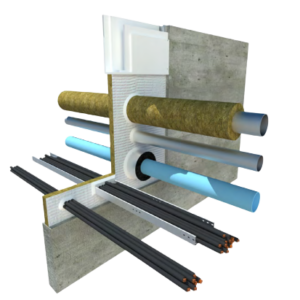 Fire Compartmentation: Safeguarding Lives and Property
Fire Compartmentation: Safeguarding Lives and Property
Introduction:
In the realm of fire safety, one concept plays a pivotal role in mitigating the spread of fires and protecting lives and property: fire compartmentation. Designed to contain and restrict the progress of fire, fire compartmentation involves the strategic division of buildings into separate compartments or fire-resistant areas. In this blog post, we will explore what fire compartmentation is, its key components, and the reasons why it is of utmost importance in the United Kingdom.
Understanding Fire Compartmentation:
Fire compartmentation entails the establishment of fire-resistant barriers, such as walls, floors, and doors, within a building. These barriers are specifically engineered to withstand the rapid spread of fire and smoke, effectively preventing their transmission from one area to another. Each compartment serves as an independent unit, isolated from adjacent spaces, with the primary aim of confining the fire to its place of origin.
Components of Fire Compartmentation:
-
Fire-Resistant Construction: Buildings are constructed using materials with fire-resistant properties, including fire-rated walls, floors, and ceilings. These elements have been tested to withstand heat and flames for a specified duration, allowing for adequate time for evacuation and firefighting efforts.
-
Fire Doors and Seals: Fire doors are an integral part of fire compartmentation. These specialised doors are designed to resist fire and smoke, providing a barrier between compartments. They are self-closing, equipped with intumescent strips that expand under heat, creating an effective seal to prevent fire and smoke from spreading.
-
Fire-Resistant Glazing: In some instances, transparent barriers, such as windows and glass partitions, are necessary. Fire-resistant glazing materials are employed in these cases, ensuring that the fire integrity of the compartment remains intact.
-
Penetration Seals: Services like electrical cables, pipes, and ventilation systems may pass through fire-rated walls and floors. To maintain the integrity of these compartments, penetration seals, such as fire-resistant gaskets, collars, and pillows, are employed to seal any gaps and prevent the spread of fire and smoke.
The Importance of Fire Compartmentation:
-
Life Safety: Fire compartmentation is crucial in safeguarding human lives. By containing the fire within its initial point of origin, the spread of flames, smoke, and toxic gases is limited, allowing occupants more time to evacuate safely. It also provides a clear path for firefighters to locate and extinguish the fire effectively.
-
Property Protection: Fire compartmentation significantly reduces the risk of extensive property damage. By isolating the fire to a specific area, the fire's potential to engulf the entire building is minimised. This containment reduces repair costs and facilitates the post-fire restoration process.
-
Firefighting Efficiency: Fire compartmentation assists firefighting operations by localising the fire. With the fire contained, firefighters can focus their efforts on controlling and extinguishing the blaze, rather than combating its rapid spread throughout the building. Legal Compliance: Fire compartmentation is a legal requirement in the United Kingdom.Building regulations, such as the Regulatory Reform (Fire Safety) Order 2005 and British Standard BS 9999:2017, mandate the implementation of fire compartmentation measures to ensure the safety of occupants and building integrity.
Conclusion:
Fire compartmentation is an indispensable fire safety strategy that significantly enhances the safety of occupants and protects property. Through the strategic placement of fire-resistant barriers, doors, and seals, the spread of fire and smoke can be effectively limited. In the United Kingdom, compliance with fire compartmentation regulations is not only crucial for the preservation of life and property but is also a legal obligation. By prioritising fire compartmentation, we can collectively contribute to a safer built environment, mitigating the devastating effects of fires and promoting greater fire resilience.

